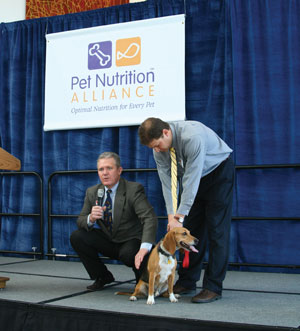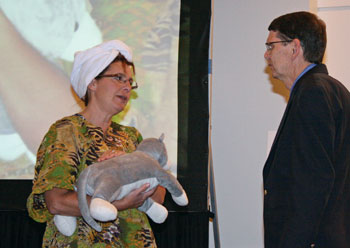Pet Nutrition Alliance advocates nutritional assessments
The new Pet Nutrition Alliance is advocating that every pet receive a nutritional assessment at every veterinary visit.
The PNA is a reincarnation of the Veterinary Companion Animal Nutritional Consortium that the American Animal Hospital Association founded two years ago in tandem with the release of the AAHA Nutritional Assessment Guidelines for Dogs and Cats. The members of the new alliance are AAHA, the AVMA, and other veterinary associations.

During the AAHA meeting in March, a press conference marked the launch of the PNA with a mission "to promote the importance of nutrition as an integral and essential component of providing optimal health care for healthy, sick, and injured pets."
The meeting also featured a presentation of the AAHA Nutrifluent workshop, which provides veterinary professionals with practical information about pet nutrition.
Pet Nutrition Alliance
"Nutrition remains the single most important environmental influencer that we as humans have on our pets," said Dr. Kate Knutson, PNA chair and AAHA president-elect, during the press conference.
Dr. Knutson said the veterinary practice team should not only complete a nutritional assessment for every pet at every visit, but also follow through with making a specific nutritional recommendation to the client.
The PNA seeks to increase awareness of proper pet nutrition and the value of nutritional assessments, Dr. Knutson said.
Dr. Donald A. Ostwald Jr. of Wheat Ridge Animal Hospital in Wheat Ridge, Colo., spoke about being a member of the task force that developed the AAHA nutritional assessment guidelines. He said the guidelines offer a basic nutritional assessment for pets in good health and an in-depth analysis for pets with certain risk factors.
Dr. Ostwald and Dr. Leonard D. Jonas, also of Wheat Ridge Animal Hospital, brought patients and clients from their practice to the stage as examples of nutritional management.
Dr. Jonas started by bringing up his own cat. The cat has hyperthyroidism but has done well on a commercial diet formulated to help manage the disease. Then a client carried her Yorkshire Terrier onto the stage. The dog has lymphangiectasia but has done well on an ultra–low-fat diet.
Another client brought up his Beagle to illustrate a dog at a healthy weight. Finally, a client brought up her overweight Labrador Retriever mix, which already had lost a few pounds since starting a weight loss diet.
Dr. Ostwald said, "A lot of patients that we consider a normal body condition score of 4, oftentimes people think that they're too thin, just because we are too used to seeing animals overweight and calling that normal."
Dr. Laura A. Eirmann, a veterinary nutritionist with Oradell Animal Hospital in Paramus, N.J., directed her comments to pet owners. She advised evaluating the reliability of sources of information about pet nutrition. She noted that a veterinarian is able to tailor a nutritional plan to an individual pet. A veterinary nutritionist can be helpful in complex cases, she added.
Dr. Knutson said the PNA corporate sponsors will help develop tools on nutrition for practice teams.
See the AAHA nutritional assessment guidelines. Information about the PNA and resources on implementing the guidelines are at www.petnutritionalliance.org.
Nutrifluent workshops
The presenters for the half-day Nutrifluent workshop were Dr. Paul Cleland, manager of technical information services and veterinary consultation services at Hill's Pet Nutrition, and Laurie Miller, a veterinary technician who is an AAHA practice consultant.
As a mnemonic device for the nutritional risk factors in the AAHA guidelines, Dr. Cleland created a list starting with the letters A through H: age, body condition score and muscle condition score, coat condition, disease and dental, extras such as treats and scraps, food—unconventional, gastrointestinal upset, and housing.
Dr. Cleland said the veterinary team already looks at most of these factors, so a nutritional assessment should not take too much more time. Miller emphasized the need to record all the information.
Another part of the nutritional assessment is to evaluate the pets' diet. Dr. Cleland asked, "How do we figure out what they're eating, what they're really eating?"
He recommended attention to components of communication that start with the letters in the word "open": open-ended requests for information, paraphrasing, empathy statements, and nonverbal communication.

Dr. Cleland went on to discuss labeling of pet foods. Many states have accepted the standards from the Association of American Feed Control Officials on labeling of pet foods, he said.
Per AAFCO, the name of the food has to appear on the front of the package along with the target animal and the net weight. Elsewhere on the package must appear the list of ingredients, in order of weight; feeding directions; name and address of the manufacturer or distributor; results of a guaranteed analysis of protein, fat, fiber, and moisture content; and a statement of nutritional adequacy. Information on calories is available from the manufacturer or distributor.
Dr. Cleland and Miller spoke about concerns with raw pet foods. They suggested making clients aware of safety issues and proper handling protocols.
"All pets deserve better food recommendations," Miller said toward the end of the workshop, suggesting that this sentence could be used as a mnemonic device for the important considerations to keep in mind when making a nutritional recommendation: appetite and acceptance, a plan for feed amount and feeding interval, disease, behavior of owners and pets, food form and follow-up, and the reason for the recommendation.
Dr. Cleland and Miller will present the Nutrifluent workshop again during the AVMA Annual Convention in August. Additional resources on nutrition are at www.everypeteverytime.com.
Pet Nutrition Alliance
American Animal Hospital Association
AVMA
American College of Veterinary Nutrition
American Society of Veterinary Medical Association Executives
Canadian VMA
National Association of Veterinary Technicians in America
World Small Animal Veterinary Association
Corporate sponsors
Hill's Pet Nutrition
Nestle Purina
P&G Pet Care